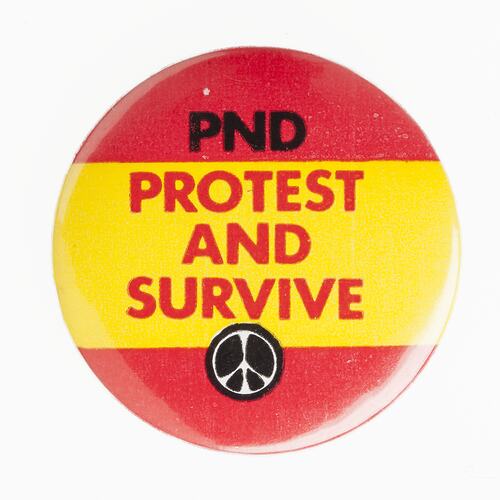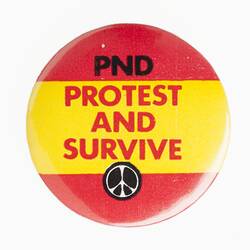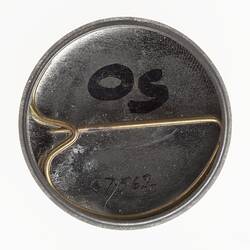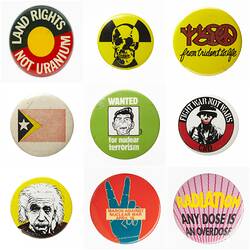Summary
Alternative Name(s): Button
This idea and design of this badge come from an initiative ran by the British Campaign for Nuclear Disarmament around1980. The slogan is a play on 'Protect and Survive', a public information series produced by the British government during the late 1970s and early 1980s. The programme consisted of pamphlets, radio broadcasts and films and it was intended to inform citizens on how to protect themselves during a nuclear attack. However, organisations like the CND thought that encouraging the idea that a nuclear war could be survived only made such a war more likely. They also published their own material, one of the examples being the "Protest and Survive" brochure made by E P Thompson. Thompson was a writer, historian and activist that had supported the anti-nuclear campaign since the beginning and was one of the most prominent figures of the movement. His parody pamphlet was published by the Campaign for Nuclear Disarmament along with the Bertrand Russell Peace Foundation. It describes the potentially destructive effects of nuclear weapons and tries to prove that the official stance will only lead to better weapons and eventually their actual use. This pamphlet was very popular and actually played a role in the revived strength of the Campaign for Nuclear Disarmament.
This particular badge, however, was produced by the PND. People For Nuclear Disarmament (PND) is a group that has been active since 1960 and are based in Sydney, Australia, with affiliates around the world. PND's objective is to mobilise public opinion towards disarmament, peace and social justice, with the eventual goal of complete world disarmament. Many PND groups evolved out of different pre-existing bodies by adopting this new name. In Victoria, the PND was formed in 1981 through a coalition of various peace organisations. The model by which it functioned was based on affiliations: from renowned peace organisations and anti-uranium groups to unions, religious bodies, political organisations, international solidarity groups. By 1983 the PND had 150 affiliates. Due to this flux and flexibility in the organisational structure, it is hard to provide an accurate history of the campaign. However, the fact that the slogan and design were adopted from Great Britain is not only proof of international solidarity in the anti-nuclear movement, but also testament to the functioning of pacifist messages and visual culture; there was certainly a sense of exchange and borrowing of slogans across campaigns worldwide.
Physical Description
Medium sized badge. Background yellow band center and red band above and below it. Upper red band black printed text. Middle yellow band red printed text. Lower area white peace symbol on black circle. Pin on back.
More Information
-
Collecting Areas
-
Acquisition Information
Donation from Nic Maclellan, 23 Feb 1987
-
Collector
-
Inscriptions
Printed text black; PND. Printed text red; Protest/ and/ survive.
-
Classification
-
Category
-
Discipline
-
Type of item
-
overall dimensions
3.3 cm (Height)
-
Keywords
Anti-Nuclear Protests, Nuclear Disarmament, Peace Issues, Political Protests, Protest Movements, Peace, Activism, Uranium Mining





